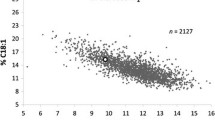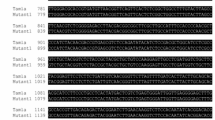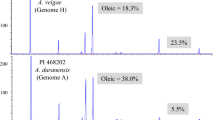Abstract
Designing the fatty acid composition of Brassica napus L. seed oil for specific applications would extend the value of this crop. A mutation in Fatty Acid Desaturase 3 (FAD3), which encodes the desaturase responsible for catalyzing the formation of α-linolenic acid (ALA; 18:3cisΔ9,12,15), in a diploid Brassica species would potentially result in useful germplasm for creating an amphidiploid displaying low ALA content in the seed oil. For this, seeds of B. oleracea (CC), one of the progenitor species of B. napus, were treated with ethyl-methane-sulfonate to induce mutations in genes encoding enzymes involved in fatty acid biosynthesis. Seeds from 1,430 M2 plants were analyzed, from which M3 seed families with 5.7–6.9 % ALA were obtained. Progeny testing and selection for low ALA content were carried out in M3–M7 generations, from which mutant lines with <2.0 % ALA were obtained. Molecular analysis revealed that the mutation was due to a single nucleotide substitution from G to A in exon 3 of FAD3, which corresponds to an amino acid residue substitution from glutamic acid to lysine. No obvious differences in the expression of the FAD3 gene were detected between wild type and mutant lines; however, evaluation of the performance of recombinant Δ-15 desaturase from mutant lines in yeast indicated reduced production of ALA. The novelty of this mutation can be inferred from the position of the point mutation in the C-genome FAD3 gene when compared to the position of mutations reported previously by other researchers. This B. oleracea mutant line has the potential to be used for the development of low-ALA B. napus and B. carinata oilseed crops.






Similar content being viewed by others
References
Ackman RG (1990) Canola fatty acids—an ideal mixture for health, nutrition, and food use. In: Shahidi F (ed) Canola and rapeseed: production, chemistry, nutrition, and processing technology. Van Nostrand Reinhold Publ, New York, pp 81–98
Alemayehu N, Becker HC (2001) Variation and inheritance of erucic acid content in Brassica carinata germplasm collections from Ethiopia. Plant Breed 120:331–335
Auld DL, Heikkinen MK, Erickson DA, Sernyk JL, Romero JE (1992) Rapeseed mutants with reduced levels of polyunsaturated fatty acids and increased levels of oleic acid. Crop Sci 32:657–662
Barret P, Delourme R, Brunel D, Jourdren C, Horvais R, Renard M (1999) Low linolenic acid level in rapeseed can be easily assessed through the detection of two single base substitution in fad3 genes. In: Proc 10th international Rapeseed congress, Canberra, Australia (CD ROM). http://www.regional.org.au/au/gcirc/4/385.htm (Accessed 7 Aug 2012)
Eskin NAM, Vaisey-Genser M, Durance-Todd S, Przybylski R (1989) Stability of low linolenic acid canola oil to frying temperatures. J Am Oil Chem Soc 66:1081–1084
Hu X, Sullivan-Gilbert M, Gupta M, Thompson SA (2006) Mapping of the loci controlling oleic and linolenic acid contents and development of fad2 and fad3 allele-specific markers in canola (Brassica napus L.). Theor Appl Genet 113:497–507
Hu X, Sullivan-Gilbert M, Gupta M, Thompson SA (2007) G-to-A mutation at the 5′ splice site of fad3c caused impaired splicing in a low linolenic mutant of canola (Brassica napus L.). Plant Biotech 24:397–400
Jain SM (2005) Major mutation-assisted plant breeding programs supported by FAO/IAEA. Plant Cell Tissue Organ Cult 82:113–123
Jourdren C, Barret P, Brunel D, Delourme R, Renard M (1996a) Specific molecular marker of the genes controlling linolenic acid content in rapeseed. Theor Appl Genet 93:512–518
Jourdren C, Barret P, Horvais R, Delourme R, Renard M (1996b) Identification of RAPD markers linked to linolenic acid genes in rapeseed. Euphytica 90:351–357
Lagercrantz U (1998) Comparative mapping between Arabidopsis thaliana and Brassica nigra indicates that Brassica genomes have evolved through extensive genome replication accompanied by chromosome fusions and frequent rearrangements. Genetics 150:1217–1228
Lagercrantz U, Lydiate DJ (1996) Comparative genome mapping in Brassica. Genetics 144:1903–1910
Lysak MA, Koch MA, Pecinka A, Schubert I (2005) Chromosome triplication found across the tribe Brassiceae. Genome Res 15:516–525
McConn M, Browse J (1996) The critical requirement for linolenic acid is pollen development, not photosynthesis, in an Arabidopsis mutant. Plant Cell 8:403–416
Merrill LI, Pike OA, Ogden LV, Dunn ML (2008) Oxidative stability of conventional and high-oleic vegetable oils with added antioxidants. J Am Oil Chem Soc 85:771–776
Mikolajczyk K, Dabert M, Karlowski WM, Spasibionek S, Nowakowska J, Cegielska-Taras T, Bartkowiak-Broda I (2010) Allele-specific SNP markers for the new low linolenic mutant genotype of winter oilseed rape. Plant Breed 129:502–507
Neff WE, Mounts TL, Rinsch WM, Konishi H, EI-Agaimy MA (1994) Oxidative stability of purified canola oil triacylglycerols with altered fatty acid compositions as affected by triacylglycerol composition and structure. J Am Oil Chem Soc 71:1101–1109
Ohlrogge J, Browse J (1995) Lipid biosynthesis. Plant Cell 7:957–970
Orthoefer FT (2005) Performance of trans-free vegetable oils in shortenings and deep-fat frying. Lipid Technol 17:101–106
Petukhov I, Malcolmson LJ, Przybylski R, Armstrong L (1999) Storage stability of potato chips fried in genetically modified canola oil. J Am Oil Chem Soc 76:889–896
Prévôt A, Perrin JL, Laclaverie G, Auge Ph, Coustllle JL (1990) A new variety of low-linolenic rapeseed oil; characteristics and room-odor tests. J Am Oil Chem Soc 67:161–164
Rahman MH (2002) Fatty acid composition of resynthesized Brassica napus and trigenomic Brassica void of genes for erucic acid in their A genomes. Plant Breed 121:357–359
Rahman MH (2004) Optimum age of siliques for rescue of hybrid embryos from crosses between Brassica oleracea, B. rapa and B. carinata. Can J Plant Sci 84:965–969
Rajcan I, Kasha KJ, Kott LS, Beversdorf WD (1999) Detection of molecular markers associated with linolenic and erucic acid levels in spring rapeseed (Brassica napus L.). Euphytica 105:173–181
Rakow G (1973) Selektion auf linol- und linolensäuregehalt in rapssamen nach mutagener behandlung. Z. Pflanzenzuchtg 69:62–82
Rakow G, Getinet A (1998) Brassica carinata an oilseed crop for Canada. Acta Hort (ISHS) 459:419–428
Röbbelen G, Nitsch A (1975) Genetical and physiological investigations on mutants for polyenoic fatty acids in rapeseed, B. napus L. I. Selection and description of new mutants. Z. Pflanzenzuchtg 75:93–105
Scarth R, Tang J (2006) Modification of Brassica oil using conventional and transgenic approaches. Crop Sci 46:1225–1236
Scheffler JA, Sharpe AG, Schmidt H, Sperling P, Parkin IAP, Lühs W, Lydiate DJ, Heinz E (1997) Desaturase multigene families of Brassica napus arose through genome duplication. Theor Appl Genet 94:583–591
Smooker AM, Wells R, Morgan C, Beaudoin F, Cho K, Fraser F, Bancroft I (2011) The identification and mapping of candidate genes and QTL involved in the fatty acid desaturation pathway in Brassica napus. Theor Appl Genet 122:1075–1090
Spasibionek S (2006) New mutants of winter rapeseed (Brassica napus L.) with changed fatty acid composition. Plant Breed 125:259–267
Tanhuanpää P, Schulman A (2002) Mapping of genes affecting linolenic acid content in Brassica rapa ssp. oleifera. Mol Breed 10:51–62
Thurling M, Depittayanan V (1992) EMS induction of early flowering mutants in spring rapeseed (Brassica napus). Plant Breed 108:177–184
Velasco L, Fernández-Martínez J, De Haro A (1995) Isolation of induced mutants in Ethiopian mustard (Brassica carinata Braun) with low levels of erucic acid. Plant Breed 114:454–456
Voelker TA, Hayes TR, Cranmer AM, Turner JC, Davies HM (1996) Genetic engineering of a quantitative trait: metabolic and genetic parameters influencing the accumulation of laurate in rapeseed. Plant J 9:229–241
Yang Q, Fan C, Guo Z, Qin J, Wu J, Li Q, Fu T, Zhou Y (2012) Identification of FAD2 and FAD3 genes in Brassica napus genome and development of allele-specific markers for high oleic and low linolenic acid contents. Theor Appl Genet 125:715–729
Acknowledgments
HR and RJW are grateful for the support provided by AVAC Ltd, the Canada Foundation for Innovation and the Research Capacity Program of Alberta Enterprise and Advanced Education. RJW is also grateful for the support provided by the Alberta Innovates Bio Solutions, Canada Research Chairs Program and the Natural Sciences and Engineering Research Council of Canada. The authors also thank Dr. Mohan Thiagarajah for suggestions on EMS treatments, Dr. Nidhi Sharma for collecting developing siliques, Ms. An Vo for FA analysis of the mutagenized populations, and other laboratory staff for the technical assistance provided.
Author information
Authors and Affiliations
Corresponding author
Additional information
Communicated by C. Quiros.
Electronic supplementary material
Below is the link to the electronic supplementary material.
122_2013_2076_MOESM1_ESM.doc
Supplementary material 1 Fig. S1 Sequence alignment of wt BoFAD3-1 from B. oleracea var. alboglabra and BnaC.FAD3.b (ortholog) from B. napus as reported by Yang et al. (2012). ‘Asterisks’ indicates identical nucleotide identities (DOC 1909 kb)
122_2013_2076_MOESM2_ESM.doc
Supplementary material 2 Fig. S2 Sequence alignment of wt BoFAD3-2 from B. oleracea var. alboglabra and BnaC.FAD3.a (ortholog) from B. napus as reported by Yang et al. (2012). ‘Asterisks’ indicates identical nucleotide identities (DOC 1935 kb)
122_2013_2076_MOESM3_ESM.doc
Supplementary material 3 Fig. S3 Comparison of BoFAD3-1 (top) and BoFAD3-2 (bottom) amino acid sequences from wt Brassica oleracea var. alboglabra. ‘Asterisk’ indicates identical amino acid identities; ‘colon’ denotes conserved substitutions; ‘dot’ designates semi-conserved substitutions (DOC 612 kb)
122_2013_2076_MOESM4_ESM.doc
Supplementary material 4 Fig. S4 Semi-quantitative RT-PCR of BoFAD3-1 and BoFAD3-2 expression in wt and low-linolenic mutant B. oleracea var. alboglabra lines. NTC, no template control; M, molecular weight ladder (DOC 910 kb)
122_2013_2076_MOESM5_ESM.doc
Supplementary material 5 Fig. S5 Analysis of desaturase activity of wt and mutant BoFAD3-1 in yeast by GC–MS. FAMEs of total lipids of Saccharomyces cerevisiae grown under inducing conditions in the presence (a) or absence (b) of 150 µM exogenously supplied C18:2. Chromatograms shown are representative of yeast bearing either wt BoFAD3-1 (wt), mutant BoFAD3-1 (mut) or empty vector (EV). Common peaks were identified as C14:0 (peak 1), C15:0 (peak 2), C15:1 (peak 3), C16:0 (peak 4), C16:1 (peak 5), C18:0 (peak 6) and C18:1 (peak 7). While C18:2 (peak 8) was produced in all lines, the level differed dramatically depending on whether the culture had been supplemented with exogenous C18:2. The standard, C17:0 (STD) is also denoted in each case. The additional C18:3 generated by the wt and mutant BoFAD3-1 enzymes in the C18:2 supplemented cultures (a) are indicated by arrows (DOC 474 kb)
Rights and permissions
About this article
Cite this article
Rahman, H., Singer, S.D. & Weselake, R.J. Development of low-linolenic acid Brassica oleracea lines through seed mutagenesis and molecular characterization of mutants. Theor Appl Genet 126, 1587–1598 (2013). https://doi.org/10.1007/s00122-013-2076-y
Received:
Accepted:
Published:
Issue Date:
DOI: https://doi.org/10.1007/s00122-013-2076-y




